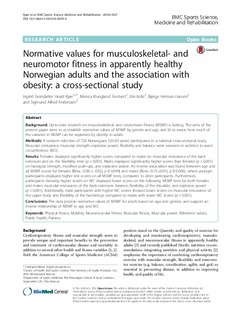| dc.contributor.author | Kjær, Ingirid Geirsdatter Heald | |
| dc.contributor.author | Torstveit, Monica Klungland | |
| dc.contributor.author | Kolle, Elin | |
| dc.contributor.author | Hansen, Bjørge Hermann | |
| dc.contributor.author | Anderssen, Sigmund Alfred | |
| dc.date.accessioned | 2017-04-06T13:22:47Z | |
| dc.date.available | 2017-04-06T13:22:47Z | |
| dc.date.created | 2017-01-05T12:34:23Z | |
| dc.date.issued | 2016 | |
| dc.identifier.citation | BMC sports science, medicine and rehabilitation. 2016, 8 . | nb_NO |
| dc.identifier.issn | 2052-1847 | |
| dc.identifier.uri | http://hdl.handle.net/11250/2437045 | |
| dc.description.abstract | Background: Up-to-date research on musculoskeletal- and neuromotor fitness (MSMF) is lacking. The aims of the present paper were to a) establish normative values of MSMF by gender and age, and b) to assess how much of the variance in MSMF can be explained by obesity in adults. Methods: A random selection of 726 Norwegians (20–65 years) participated in a national cross-sectional study. Muscular endurance, muscular strength, explosive power, flexibility and balance were assessed in addition to waist circumference (WC). Results: Females displayed significantly higher scores compared to males on muscular endurance of the back extensors and on the flexibility tests (p < 0.001). Males displayed significantly higher scores than females (p < 0.001) on handgrip strength, modified push-ups, and explosive power. An inverse association was found between age and all MSMF scores for females (Beta:−0.06–(−0.92), p ≤ 0.044) and males (Beta:−0.15–(0.91), p ≤ 0.006), where younger participants displayed higher test scores on all MSMF tests, compared to older participants. Furthermore, participants showing higher scores on WC displayed lower scores on the following MSMF tests for both females and males: muscular endurance of the back extensors, balance, flexibility of the shoulder, and explosive power (p < 0.001). Additionally, male participants with higher WC scores showed lower scores on muscular endurance of the upper body and flexibility of the hamstrings compared to males with lower WC scores (p < 0.001). Conclusions: The data provide normative values of MSMF for adults based on age and gender, and support an inverse relationship of MSMF to age and WC. | |
| dc.language.iso | eng | nb_NO |
| dc.rights | Navngivelse-Ikkekommersiell-DelPåSammeVilkår 4.0 Internasjonal | * |
| dc.rights.uri | http://creativecommons.org/licenses/by-nc-sa/4.0/deed.no | * |
| dc.title | Normative values for musculoskeletal- and neuromotor fitness in apparently healthy Norwegian adults and the association with obesity: a cross-sectional study | nb_NO |
| dc.type | Journal article | nb_NO |
| dc.type | Peer reviewed | nb_NO |
| dc.source.pagenumber | 9 | nb_NO |
| dc.source.volume | 8 | nb_NO |
| dc.source.journal | BMC sports science, medicine and rehabilitation | nb_NO |
| dc.identifier.doi | 10.1186/s13102-016-0059-4 | |
| dc.identifier.cristin | 1421558 | |
| cristin.unitcode | 201,18,2,0 | |
| cristin.unitname | Institutt for folkehelse, idrett og ernæring | |
| cristin.ispublished | true | |
| cristin.fulltext | original | |
| cristin.qualitycode | 1 | |

